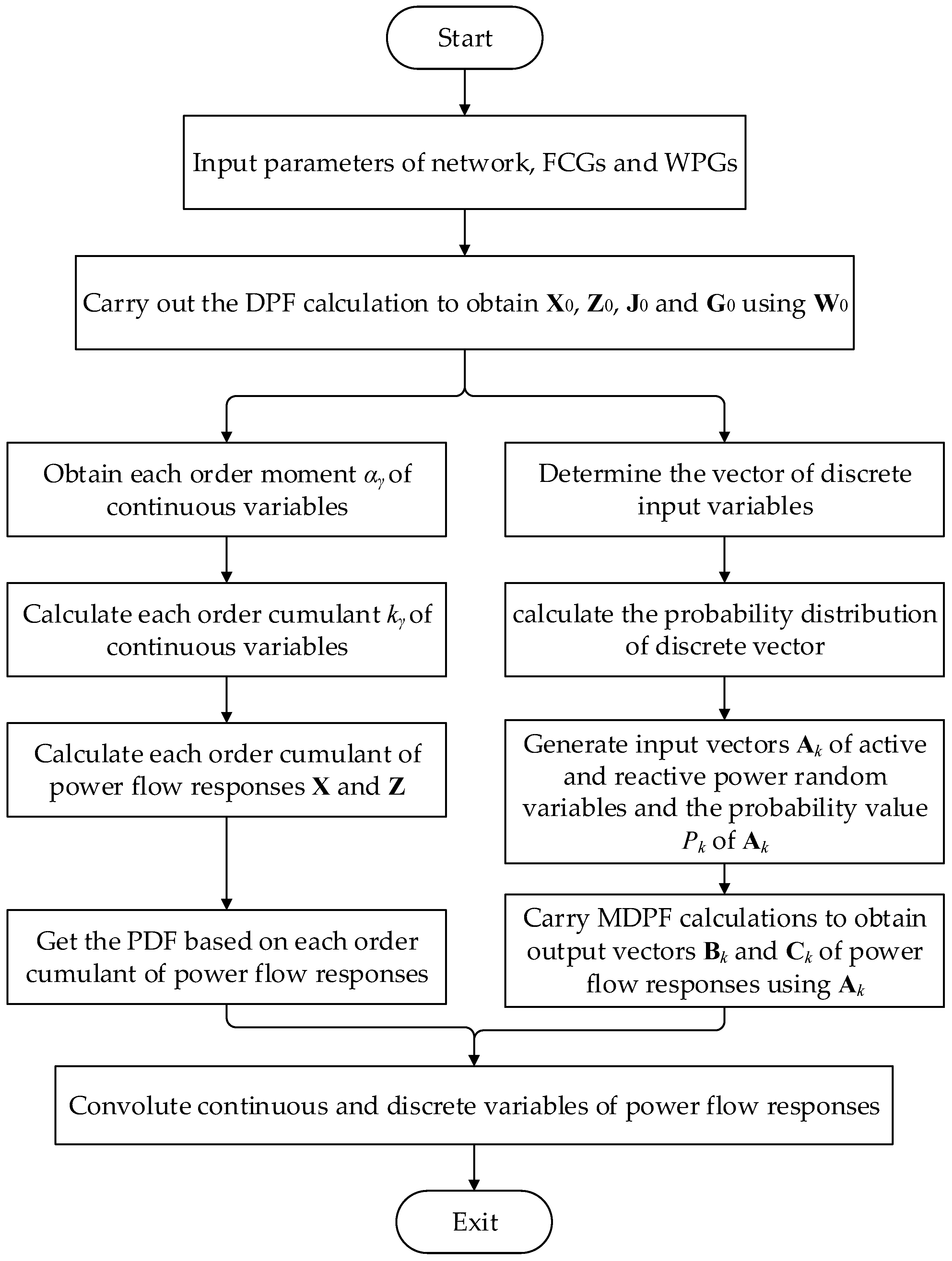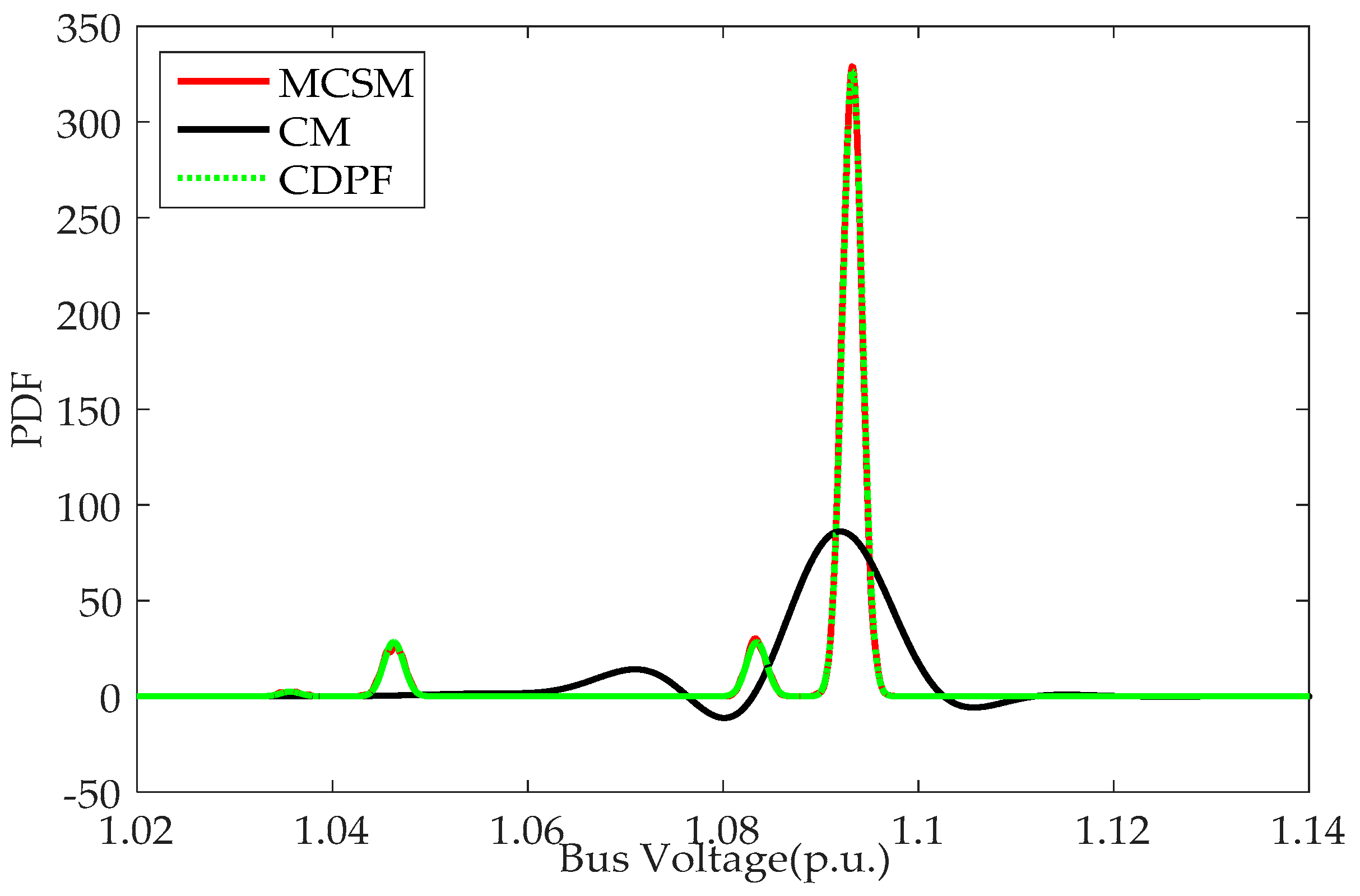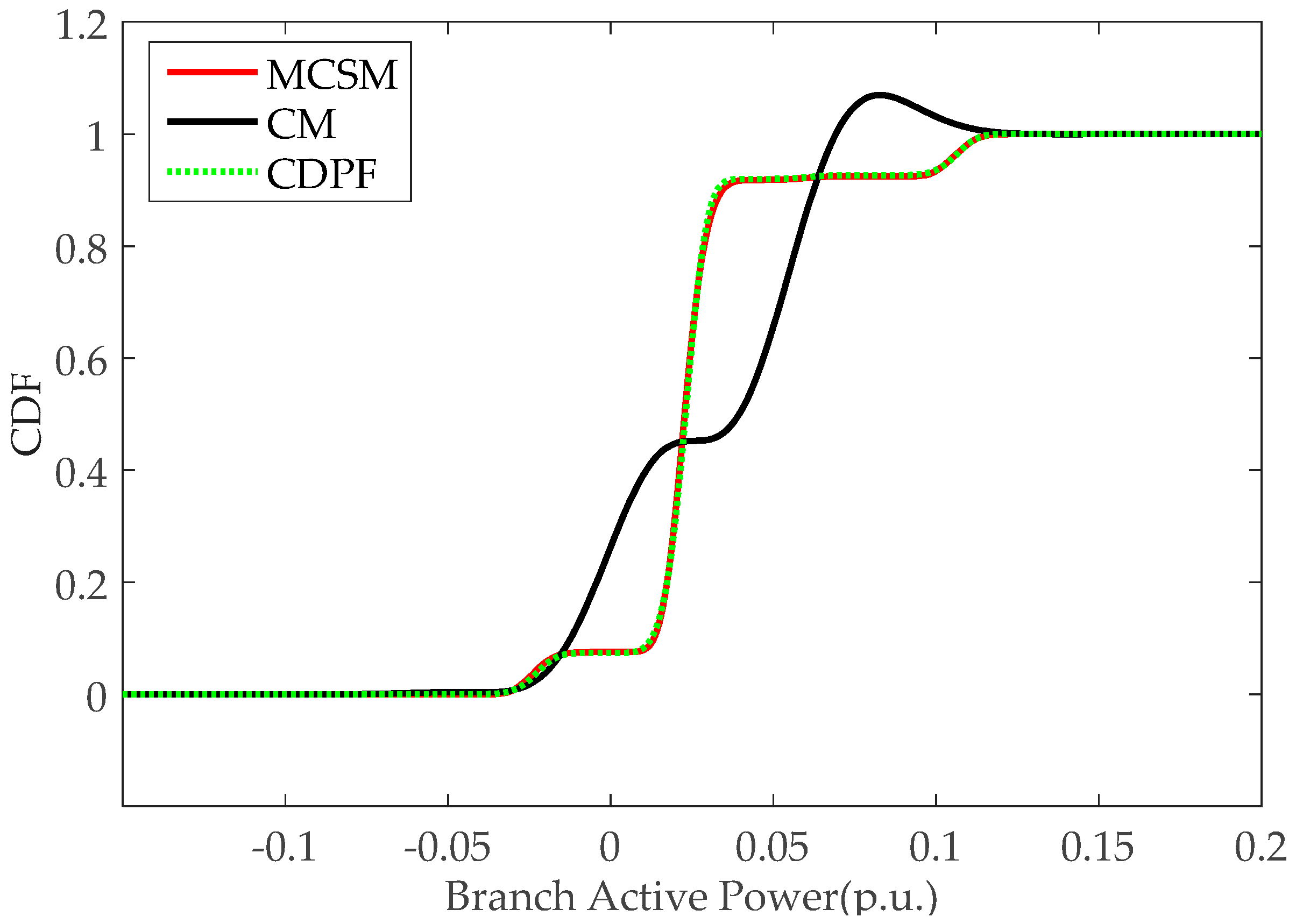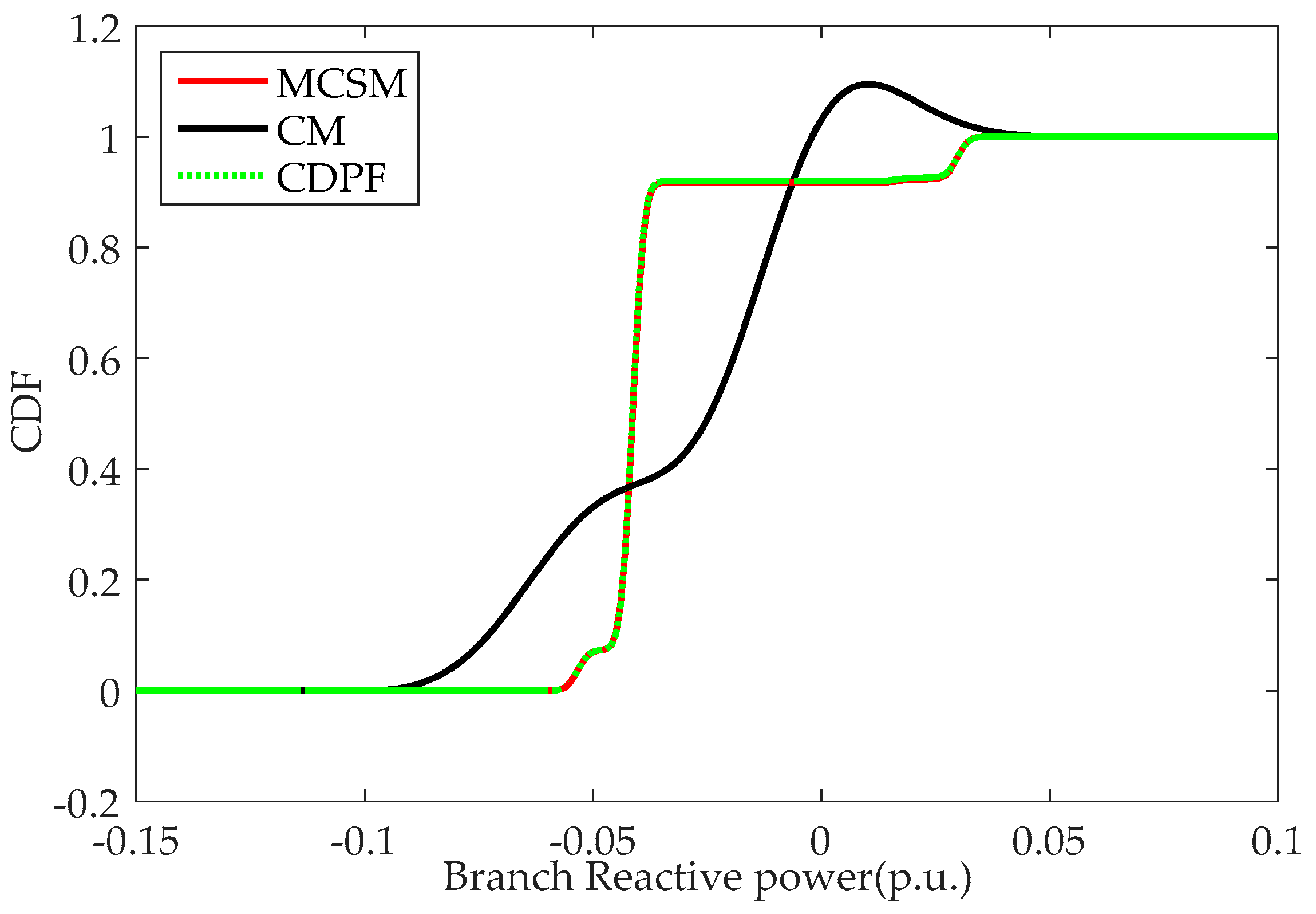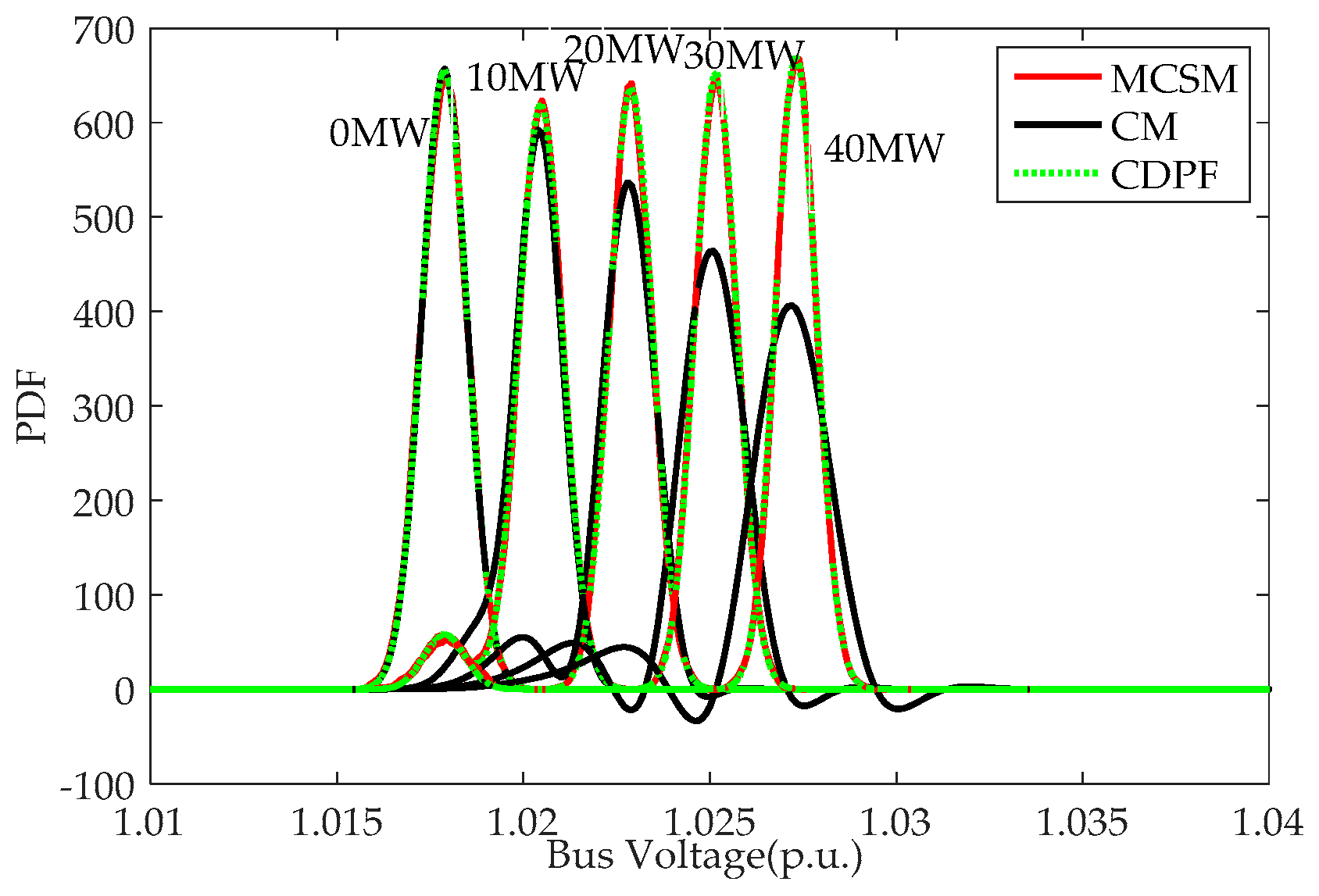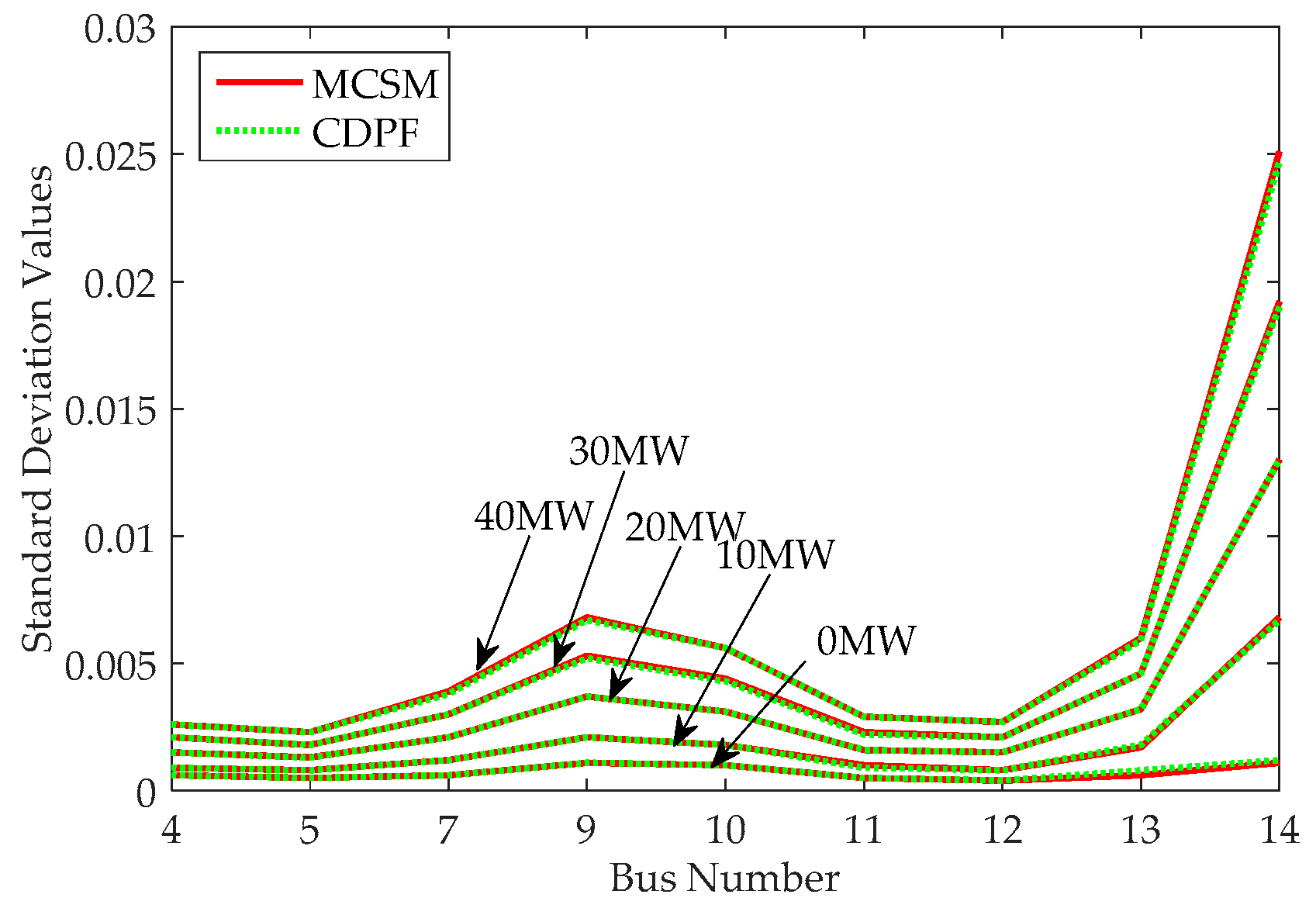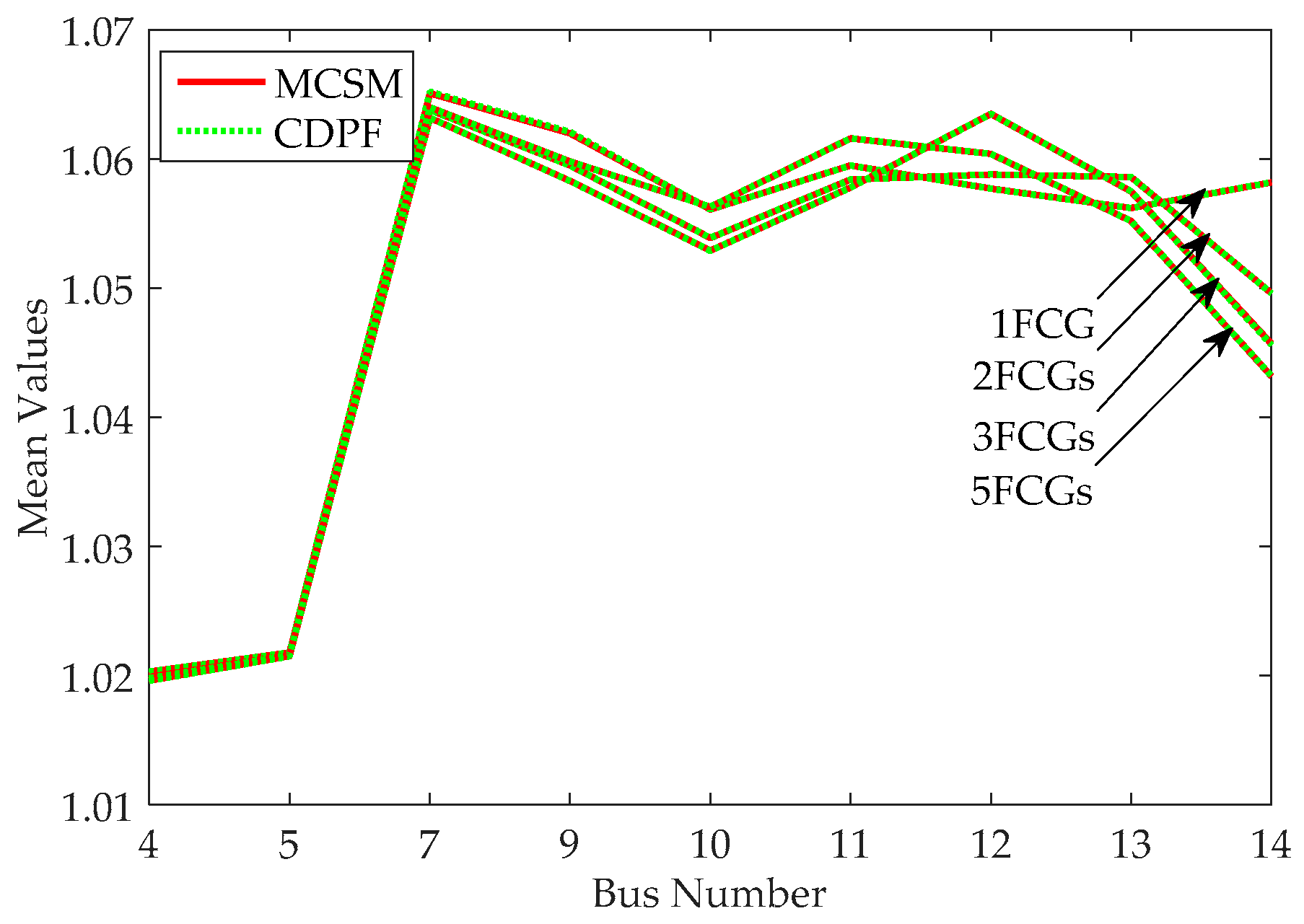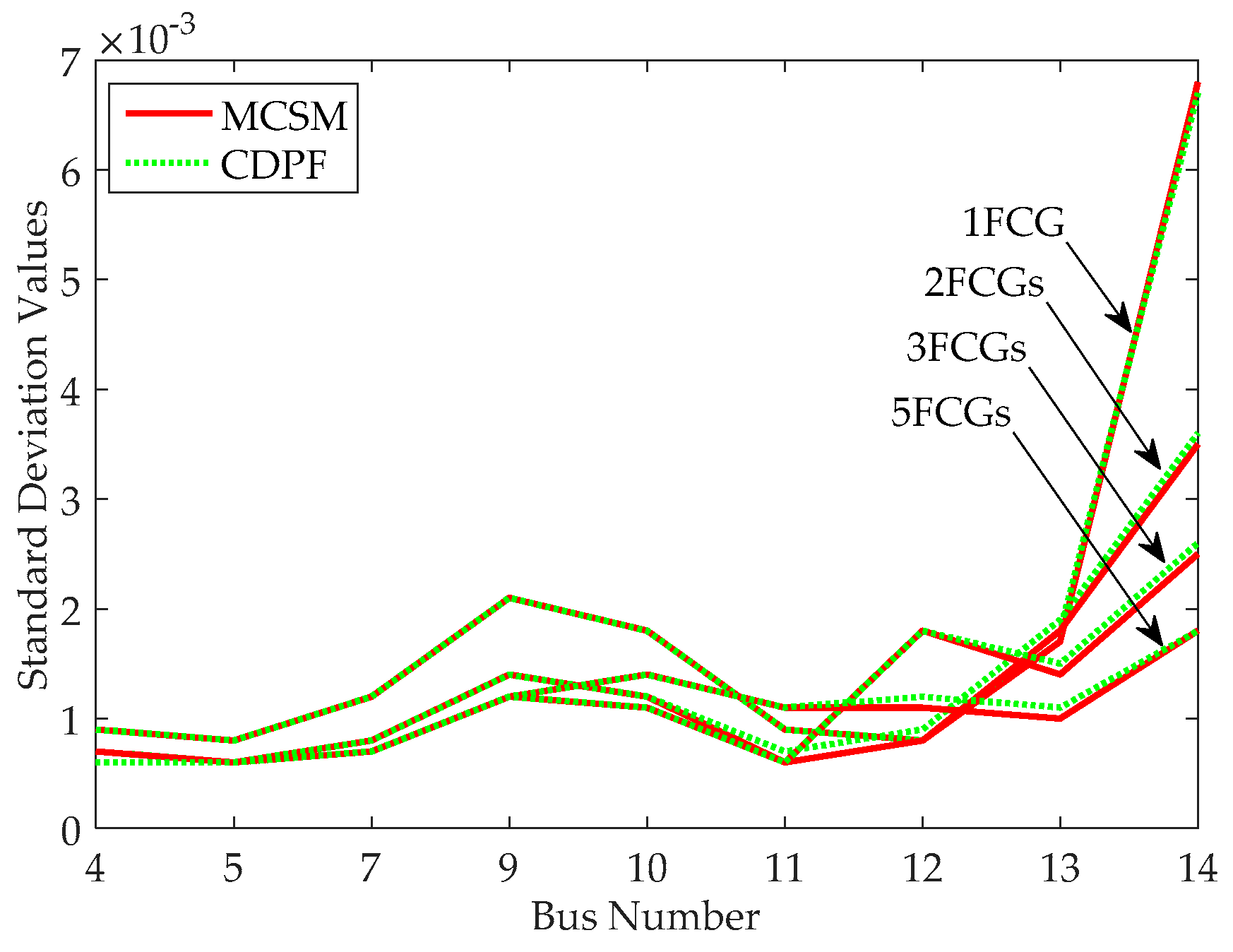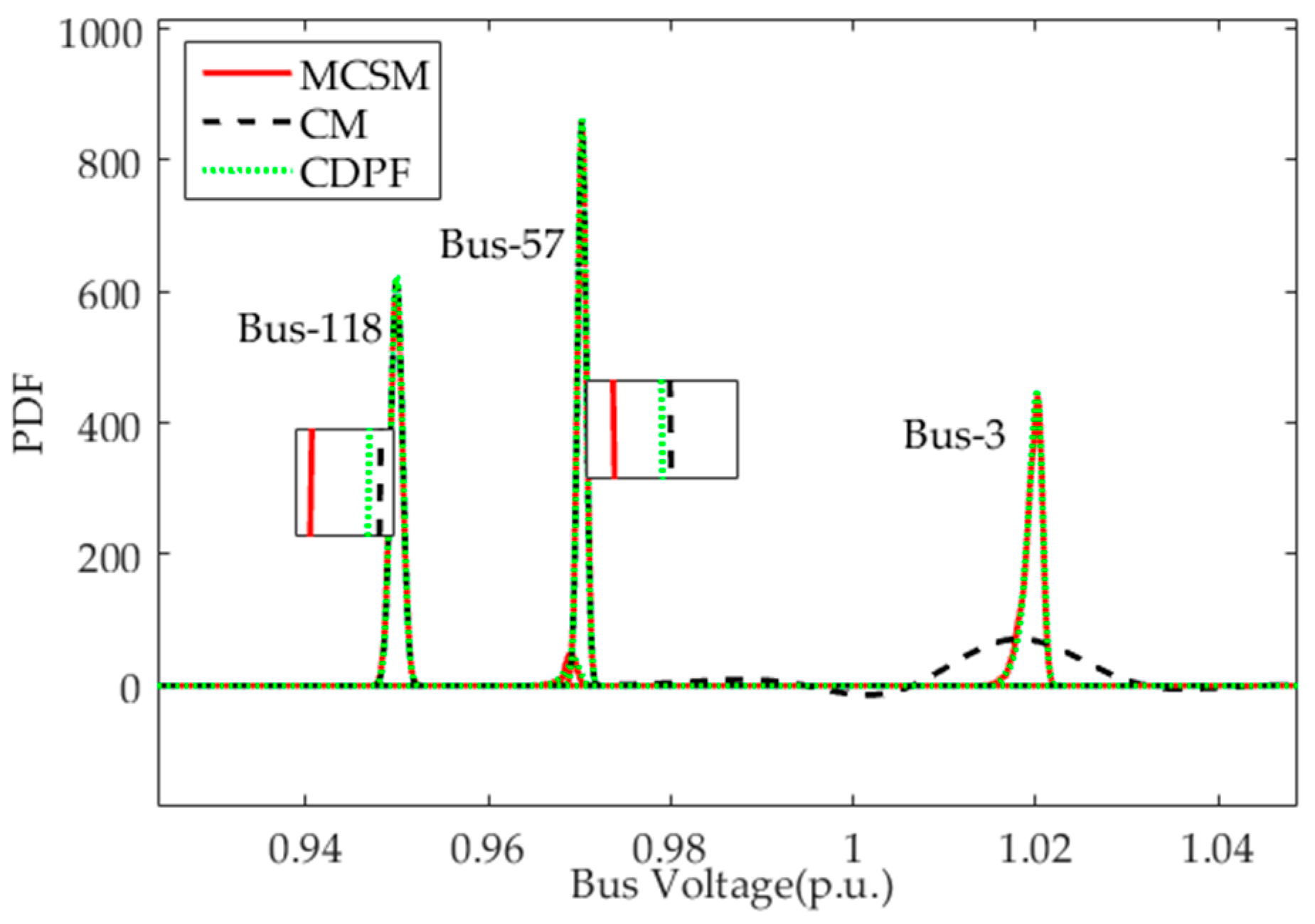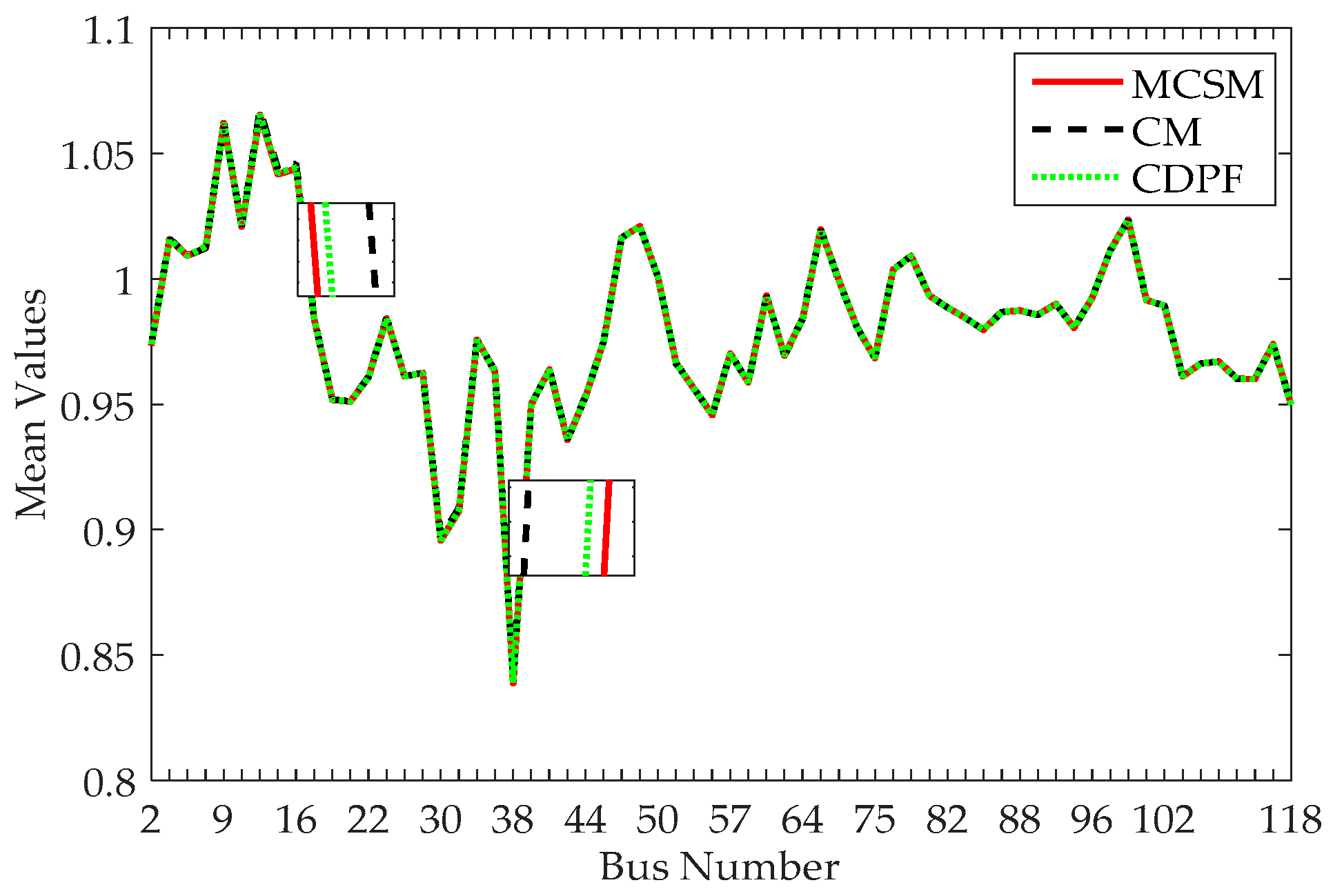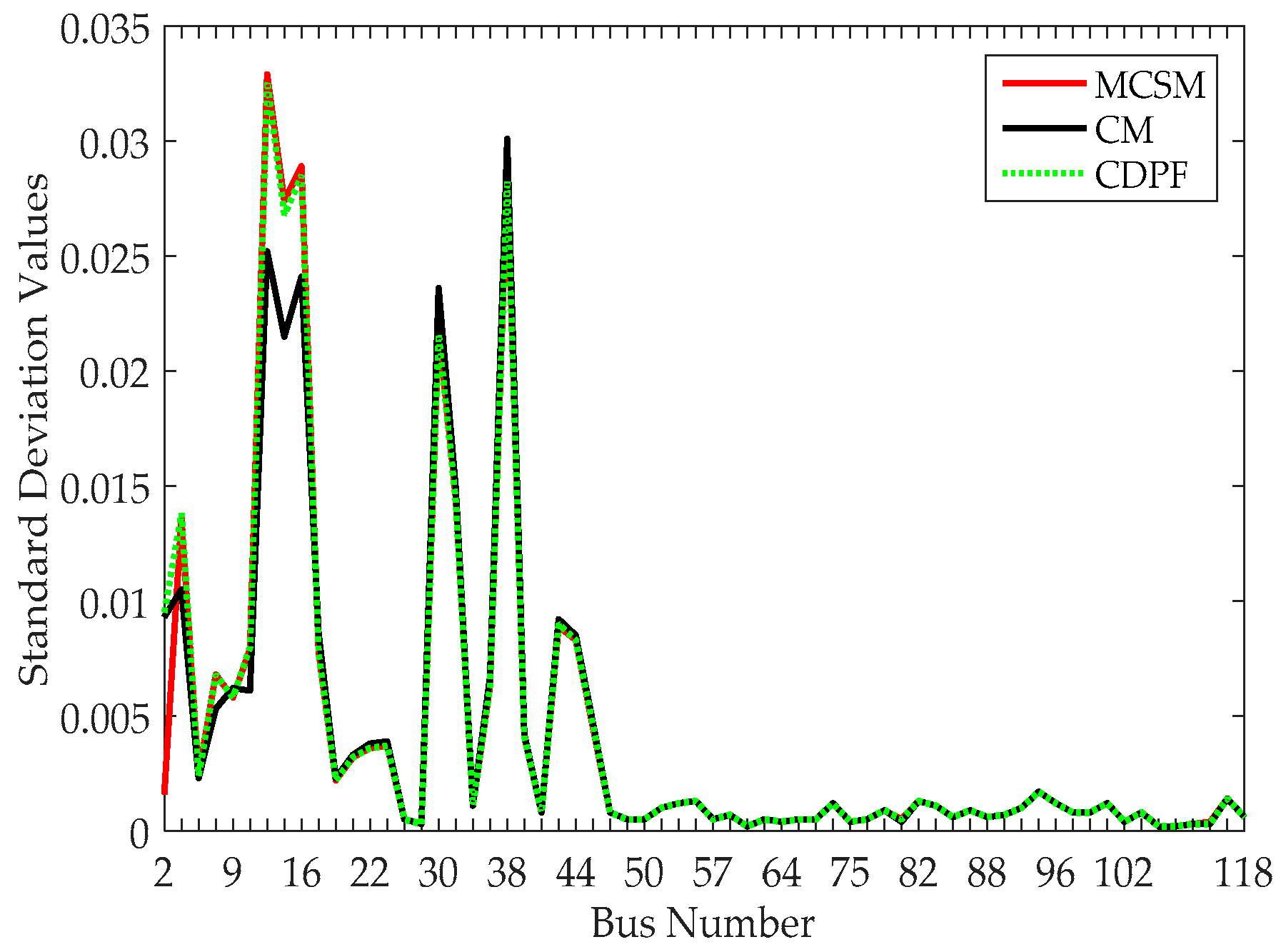1. Introduction
Probabilistic power flow (PPF) was first proposed by Borkowska in 1974 [
1], and is an effective probabilistic analysis method for the exploration of the influence of stochastic factors on power systems [
2]. Stochastic factors such as loads, wind power generations (WPGs), and fuel cell generations (FCGs) exist widely in practical power systems [
3]. Deterministic power flow (DPF) calculations cannot comprehensively evaluate the effects on power systems because of various stochastic factors. However, PPF can completely investigate various stochastic factors and obtain probability distributions of power flow responses (bus voltages and branch power flows), such as probability density functions (PDFs) and cumulative density functions (CDFs) [
4]. Therefore, calculation results achieved by the PPF method can better reflect the operating characteristics of power systems.
PPF methods mainly include three categories: simulation methods [
5,
6,
7], approximate methods [
8,
9,
10,
11], and analytical methods [
12,
13,
14,
15,
16]. Among simulation methods, the Monte Carlo simulation method (MCSM) is an outstanding representation, and it is regarded as a standard to evaluate the accuracy and efficiency of other PPF methods. However, MCSM requires tens of thousands of DPF calculations to converge. This computational burden greatly reduces MCSM’s efficiency [
17].
To improve the computational speed of MCSM, a point estimate method (PEM) is proposed, which is a classical approximate method. Nevertheless, probability distributions of power flow responses cannot be attained accurately because large errors of high order moments are unavoidable [
18].
To obtain the probability distributions of power flow responses accurately and reduce errors from PEM, cumulant method (CM) is presented, which is an analytical method. PDFs and CDFs of power flow responses can be obtained by CM accurately and efficiently for PPF problems [
19,
20]. Nonetheless, errors based on CM still exist, and mainly consist of two classes: (1) linearization errors—when non-linear power flow equations are linearized into linear power flow equations by ignoring high-order terms of Taylor series expression, linearization errors are formed [
21]; and (2) series expansion errors—when series diverge, such as the Gram-Charlier series (GCS) [
22], PDFs will appear negative or CDFs will be more than 1 [
14]. In a word, two types of errors are mainly derived from the fluctuation of stochastic variables. The larger the fluctuation range of stochastic variables is, the larger the errors are.
To reduce errors in CM, many research achievements have been developed. Hong et al. [
23] focus on decreasing linearization errors when the sensitivity matrix of PPF is singular. However, only continuous variables are considered in this paper. Sanabria & Dillon [
24] and Hu & Wang [
25] present the von Mises method to deal with discrete variables. However, probability distributions of power flow responses cannot be obtained accurately, because the von Mises method handles discrete variables with an approximate approach. Leite da Silva and Arienti [
26] used multiple points of linearization to decrease errors from linear power flow equations considering only continuous variables. Meanwhile, searching linearization points is a challenge. Li et al. [
27] adopt the same algorithm from [
26], considering discrete and continuous variables. Wu et al. [
28] present a multiple integral method based on CM to reduce the calculation burden and improve the computational accuracy. However, the number of input random variables is limited, as well as discrete variables that are not involved in this paper. Cai et al. [
29] applied MCSM to calculate the cumulants of random input variables with complex probability distributions, but this method cannot diminish errors in CM. When the number of discrete variables increases, the fluctuation range of input random variables will be extended.
In existing studies, FCG and branch outages are two typical discrete variables [
25,
30]. With FCG becoming a prospective generator as a discrete variable, that discrete variable causes the fluctuation range of random input variables larger in CM to become a notable issue. Furthermore, continuous and discrete variables are seldom considered simultaneously, and cannot be addressed accurately based only on CM. As a result, it is a challenge for CM to solve these problems [
31].
In order to solve PPF problems with continuous and discrete variables accurately, this paper presents a novel PPF method considering continuous and discrete variables (CDPF). In CDPF, CM is employed to handle continuous variables and multiple DPF (MDPF) calculations are presented to deal with discrete variables. Then, probability distributions of power flow responses can be calculated accurately and efficiently by the convolution of continuous and discrete variables of power flow responses. The main contributions of this paper include following aspects:
- (1)
This paper proposes a novel PPF method (CDPF) that can accurately solve PPF problems with continuous and discrete variables simultaneously. In CDPF, multiple probability distributions of continuous variables and discrete variables can be considered together, such as normal distribution (loads), non-normal distribution (WPGs), and binomial distribution (FCGs).
- (2)
This paper investigates two issues affecting power systems: (1) What are effects of a discrete variable (FCG) under different rated powers on power systems in Case 2,
Section 4; and (2) How can we address multiple discrete variables (FCGs) in power systems in Case 3,
Section 4?
- (3)
The accuracy and efficiency of CDPF are verified quite well compared with results of bus voltages and branch power flows obtained by CDPF, CM, and MCSM in IEEE 14-bus and IEEE 118-bus power systems.
The main framework of this paper is organized as follows:
Section 2 introduces probability distributions of WPGs, FCGs, and loads which are used in this paper;
Section 3 describes the CDPF method in detail;
Section 4 shows case studies and analysis results; and
Section 5 draws conclusions.
3. CDPF Method
In CDPF, PDFs of power flow responses considering continuous variables (PWPG, QWPG, PL, QL) can be obtained by CM. Then, probability distributions of the power flow responses that consider the discrete variables (PFCG, QFCG) can be accurately calculated by MDPF calculations. Moreover, PDFs of power flow responses considering all of the variables can be achieved accurately and efficiently by the convolution of the above two results (CM and MDPF). In this section, fundamental theories, concepts, and implementations of CDPF are stated in detail.
3.1. Power Flow Responses with Continuous Variables Based on CM
3.1.1. Calculation on Continuous Variable Cumulants
In CM, cumulants of continuous variables are calculated based on an analytical method. The
γ order moment of continuous variable
x is defined as follows [
33]:
where
γ is the order number of moments and
f(
x) is the PDF of
x, where
x is the
PWPG (or
QWPG,
PL,
QL) in this paper.
The relationship between the
γ order cumulant
kγ and the moments can be described as follows [
33]:
3.1.2. Linear Power Flow Equations
Nonlinear power flow equations can be written as follows [
34]:
where
W is the vector composed of the active and reactive power from generations and loads.
X is the vector composed of voltage amplitudes and voltage phase angles at all buses.
Z is the vector composed of the active and reactive power of branch power flows.
f(
x) and
g(
x) are, respectively, functions of the bus voltage and brand power flow.
Equation (8) is linearized into Equation (9) at
X0 and
Z0. Linear power flow equations are as follows [
34]:
where
X0 and
Z0 are, respectively, mean vectors of bus voltages and branch power flows,
J0 is the Jacobi matrix obtained by DPF calculation in the maximal iteration, Δ
W is each order cumulant vector composed of the active and reactive power from generations and loads, and
G0 is the sensitivity matrix of the branch power flow function
g(
x).
According to Equation (9), each order cumulant vector of X and Z can be obtained efficiently.
3.1.3. Estimation on Probability Distributions of Power Flow Responses
According to each order cumulant vector of
X and
Z, probability distributions of bus voltages and branch power flows can be obtained based on GCS. GCS can be expressed as Equation (10) [
35]:
where
fX(
x) is the PDF of the power flow response,
f0(
x) is the PDF of the standard normal distribution,
λi is the coefficient of series expansion, and
Hi is the
ith order Hermite orthogonal polynomial.
3.2. Power Flow Responses with Discrete Variables Based on MDPF Calculations
3.2.1. Determination on the Vector of Discrete Variables
Suppose that
n FCGs are regarded as
n discrete variables
Xi (where
) in a power system. The vector
X of discrete variables is defined as follows:
where
X denotes the output power vector of FCGs.
Xi can be expressed as follows:
where the number of work statuses on the
ith FCG
Xi is
Ji, and
is the output power of the
ith FCG
Xi at the
ji work status.
The probability distribution of
Xi can be shown as follows:
where
is the probability value of
when the
ith fuel cell
Xi works at
ji status.
Pi is the probability distribution.
Supposing that
n discrete variables [
X1,
X2, …,
Xi, …,
Xn] are independent of each other, the probability distribution of
X can be denoted as Equation (14):
3.2.2. Determination on the Active Power and Reactive Power Vector of Generations and Loads
Input vectors in MDPF calculations include the active power and reactive power of continuous and discrete variables. For continuous variables, input values of the active power and reactive power are corresponding mean values of WPGs, and the loads are stated as Ec1, Ec2, …, Ecm. Subscripts c1, c2, …, cm are numbers of injection buses. m is the number of continuous variables.
For discrete variables, values of the active power and reactive power of FCGs can be described as follows:
Input vectors in the MDPF calculation can be described as follows:
where
k is from 1 to
J1·
J2·…·
Jn. The dimension of
Ak is
N which is the number of buses of the power system. Note that “0” elements in
Ak denote no input power or output power.
3.2.3. Calculations Based on MDPF
Take
Ak of Equation (16) as the
kth active power and reactive power vector
Wk in Equation (8); then, power flow responses (bus voltages and branch power flows) can be obtained using
Wk based on the DPF calculation. The bus voltage vectors can be described as follows:
where
U1,
U2, …,
UN are, respectively, bus voltages of bus-1, bus-2, …, bus-
N, and
N is the bus number of the power system.
Using the same method, vectors of branch power flows Ck also can be obtained, and numbers of B and C are both J1·J2·…·Jn.
3.3. Convolution of Continuous and Discrete Variables
When multiple input random variables
exist in the power system, Equation (9) can be further expressed as follows:
However, if all input random variables are convoluted by Equations (18) and (19), the computation efficiency of CDPF will decrease. Considering the accuracy and efficiency of the PPF calculation, random input variables of power systems are only divided into two categories: continuous and discrete random variables, in this paper. Therefore, Equations (18) and (19) can be stated as follows:
where Δ
Wc and Δ
Wd are, respectively, continuous and discrete vectors, and “*” is the convolution operator of multiple random variables.
According to Equation (20), results X and Z of PPF can be efficiently and accurately obtained by the convolution of continuous and discrete variables.
The convolution operation of continuous and discrete variables can be described as follows:
where
Y is the random variable that needs to be obtained,
CW and
DW are, respectively, continuous and discrete variables.
PDF and CDF of
Y are defined as follows [
25]:
where
fY(
x) and
FY(
x) are, respectively, PDF and CDF of
Y.
n is the number of discrete points of
DW,
xi and
pi are, respectively, the discrete point value and the probability value of
DW, and
is the PDF of
CW.
3.4. Implementation Procedure of CDPF
Step (1) Set the system parameters of the power system, probability distribution parameters, and bus numbers of input random variables including WPGs, loads, and FCGs.
Step (2) Carry out a DPF calculation to obtain X0, Z0, J0, and G0 using W0.
Step (3) Obtain each order moment αγ of the continuous variables by using Equation (6).
Step (4) Calculate each order cumulant kγ of the continuous variables by using Equation (7), based on the moment αγ obtained by Step 3.
Step (5) Calculate each order cumulant of the power flow responses X and Z according to Equation (9).
Step (6) Obtain the PDF based on each order cumulant of the power flow responses according to Equation (10) and then integrate the PDF to acquire the CDF.
Step (7) Determine the vector of discrete input variables according to Equations (11) and (12). Then, calculate the probability distribution of discrete vector according to Equations (13) and (14).
Step (8) Generate input vectors Ak of the random active and reactive power variables and the probability value Pk of Ak according to Equations (16) and (14).
Step (9) Carry out MDPF calculations to obtain the output vectors Bk and Ck of the power flow responses using Ak, and the probability value of each Bk or Ck is Pk according to Equations (8) and (14).
Step (10) Convolute continuous and discrete variables of power flow responses obtained, respectively, from Step 6 and Step 9 according to Equations (22) and (23). Convolution results are power flow responses considering all continuous and discrete variables.
Figure 1 is the flowchart of the power flow considering continuous and discrete variables (CDPF) method.
5. Conclusions
A novel PPF method considering continuous and discrete variables, called CDPF, is proposed in this paper. The mean, standard deviation, PDF, and CDF of power flow responses can be calculated accurately and efficiently by the proposed method. Continuous variables following a normal distribution or non-normal distribution and discrete variables following binomial distribution can be solved by the proposed method. The accuracy, efficiency, and applicability of the proposed method are demonstrated by comparing MCSM, CM and CDPF in IEEE 14-bus and IEEE 118-bus power systems. Conclusions are summarized as follows:
- (1)
CDPF has better performance in computation speed compared with MCSM. Additionally, CDPF has a better performance in computation accuracy than CM, especially for the case with the large fluctuation range of input random variables.
- (2)
CDPF has good performance in the applicability to deal with a discrete variable with different rated powers and multiple discrete variables in power systems.
- (3)
CDPF has good performance in the applicability to address large power systems with high accuracy and efficiency.
In the future, the idea of the proposed method can be applied to other uncertainty analytical problems, such as the probabilistic static stability and the probabilistic reactive power control, and so on.
